
Caenorhabditis elegans is a free-living transparent nematode about 1 mm in length that lives in temperate soil environments. It is the type species of its genus. The name is a blend of the Greek caeno- (recent), rhabditis (rod-like) and Latin elegans (elegant). In 1900, Maupas initially named it Rhabditides elegans. Osche placed it in the subgenus Caenorhabditis in 1952, and in 1955, Dougherty raised Caenorhabditis to the status of genus.

Cynthia Jane Kenyon is an American molecular biologist and biogerontologist known for her genetic dissection of aging in a widely used model organism, the roundworm Caenorhabditis elegans. She is the vice president of aging research at Calico Research Labs, and emeritus professor of biochemistry and biophysics at the University of California, San Francisco (UCSF).

Alexander Carl Heinrich Braun was a German botanist from Regensburg, Bavaria. His research centered on the morphology of plants.
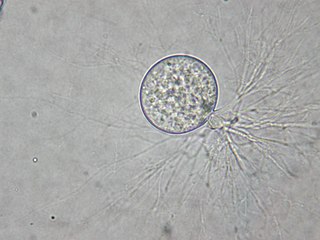
Fungi of the order Chytridiales, like other members of its division, may either have a monocentric thallus or a polycentric rhizomycelium. When the ribosomal genes of members classified in this order were first examined using molecular techniques, it was discovered that the order contained some species that were not related. With the culture and characterization of Chytridium olla, the type species of this order, the limits of the Chytridiales were established. The Chytridiales is now monophyletic and species such as Polychytrium aggregatum, Chytriomyces angularis and Cladochytrium replicatum have been transferred to other orders.
Chersotis elegans is a moth of the family Noctuidae. It is found in the mountains of Spain, Greece, Turkey, the Caucasus, Lebanon, Israel and western central Asia.

Enneapterygius elegans, the hourglass triplefin, is a species of triplefin blenny in the genus Enneapterygius. It was originally described by Wilhelm Peters as a species of Tripterygium, in 1876, but was reassigned to Enneapterygius by W. Holleman in 1986. It is a tropical blenny known from reefs across the western central Indian to the central Pacific Ocean, and swims at a depth range of 0–12 metres. Male hourglass triplefins can reach a maximum length of 4 centimetres. The blenny gets its common name from an hourglass-shaped marking on its body.
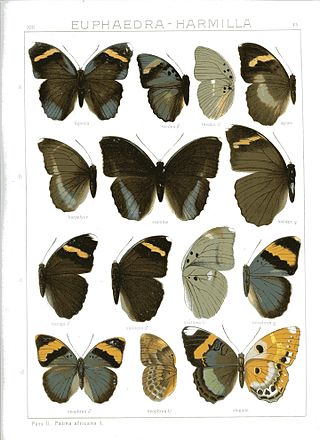
Harmilla is a butterfly genus in the family Nymphalidae. It contains only one species, Harmilla elegans, the elegant forester, which is found in Nigeria, Cameroon, the Republic of the Congo, the Democratic Republic of the Congo and Uganda. The habitat consists of swamp forests with a dense understorey.

Bero elegans is a species of marine ray-finned fish belonging to the family Cottidae, the typical sculpins. This species is found in the northwestern Pacific Ocean. This species grows to a length of 20 centimetres (7.9 in) TL. It is the only known member of the genus Bero.
Olpidiaceae is a fungal plant pathogen family of genera that was placed in the order Olpidiales.

Chytriomyces is the type genus of fungi in the family Chytriomycetaceae. The genus was described by mycologist John Sidney Karling in 1945. The family, created by Peter Letcher in 2011, contains species with a Group I-type zoospore, distinguishing it from Chytridiaceae members, which have a Group II-type zoospore.
Dendrochytridium is a fungal genus in the order Chytridiales. The genus is monotypic, containing the single saprobic species Dendrochytridium crassum, isolated from detritus collected from an Australian tree canopy. Both the genus and species were described as new to science in 2013. Phylogenetically, Dendrochytridium crassum groups together in a clade with other fungi possessing Group II-type zoospores. These fungi, which include representatives from the genera Chytridium, Phlyctochytrium, Chytriomyces, and Polyphlyctis are classified in the family Chytridiaceae.
Prioniodus is an extinct genus of conodonts in the family Balognathidae from the Ordovician.
Chitaura elegans is a species of grasshopper found in Indo-Malaysia.

Caulophacus elegans is a species of glass sponges belonging to the subfamily Lanuginellinae. The type specimen has been found in Central Kuroshio Current, near Japan.

Cucullanus elegans is a species of parasitic nematode. It is an endoparasite of the European perch.

Catenipora is an extinct genus of tabulate corals in the family Halysitidae, known from the Ordovician to the Silurian.
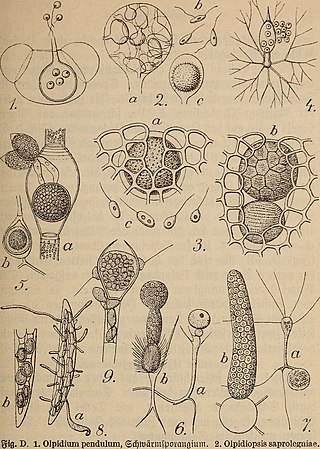
Chytridium is a genus of fungi in the family Chytridiaceae.
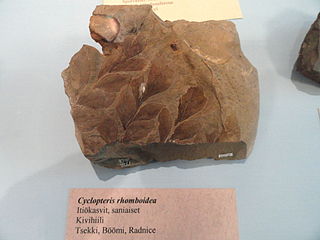
Cyclopteris is an extinct genus of seed ferns in the extinct family †Cyclopteridaceae. Species are from the Carboniferous.

Kyphosus elegans, the Chopa Mojonera or Cortez chub, is a species of marine ray-finned fish, a sea chub from the family Kyphosidae. It is found in the eastern Pacific Ocean where it is of minor importance to commercial fisheries.
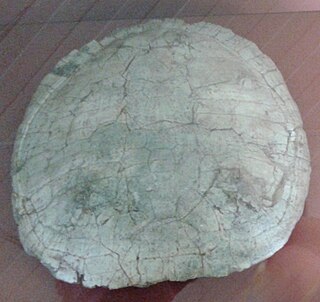
Bauruemys is an extinct genus of turtles in the family Podocnemididae.













